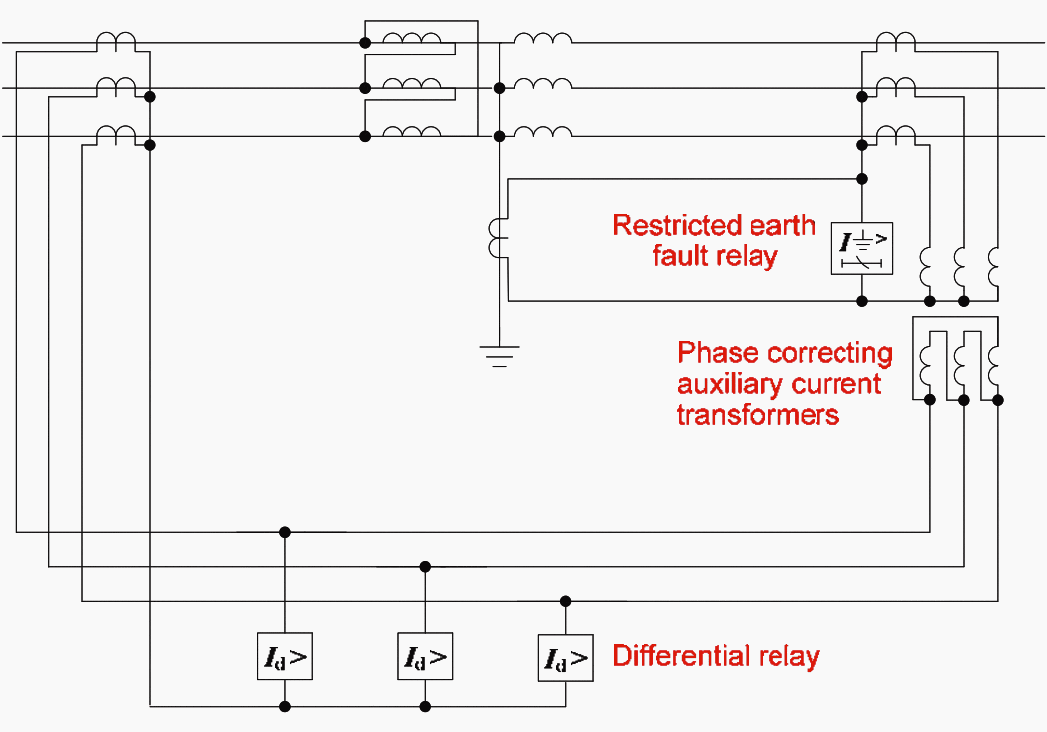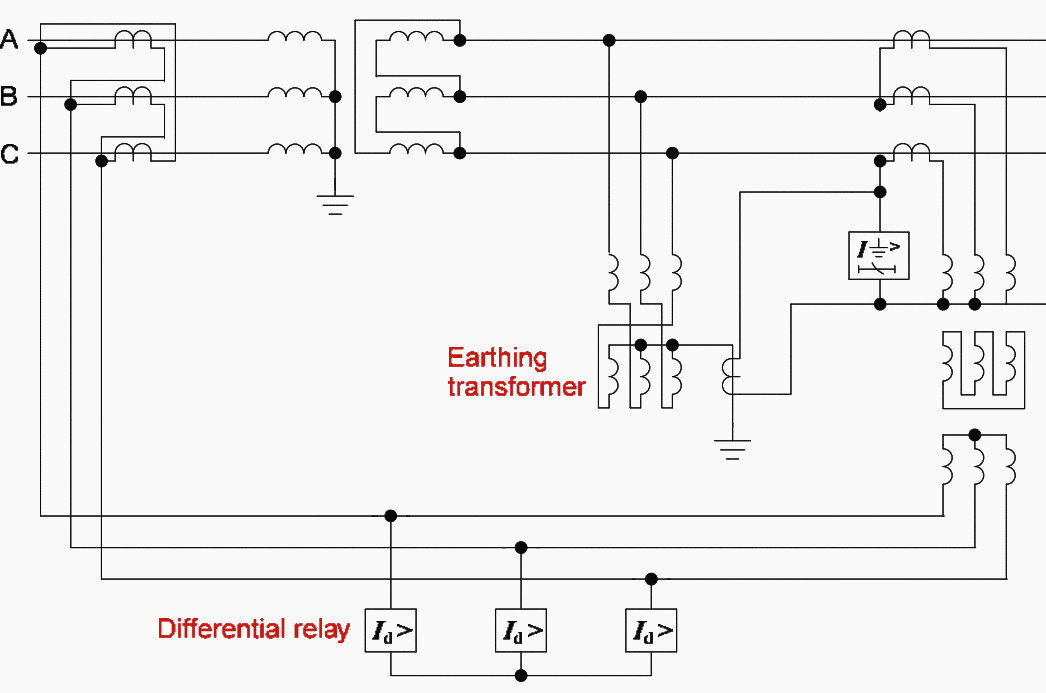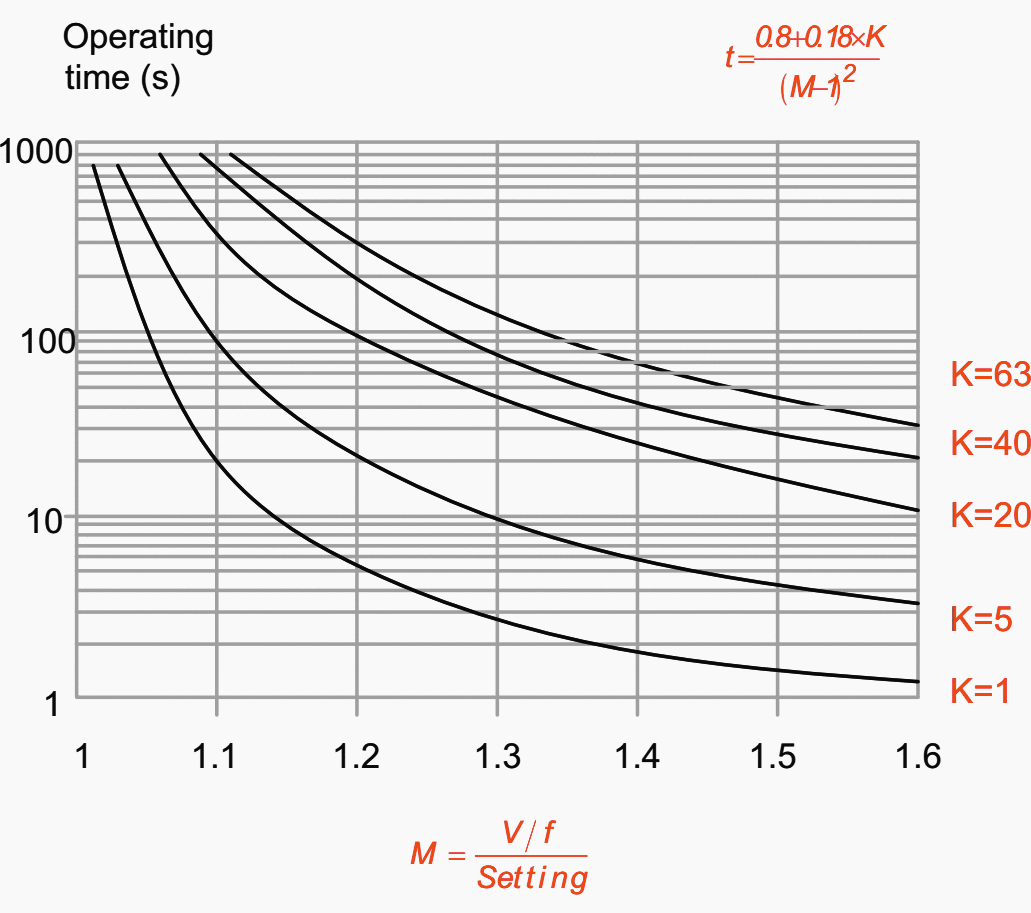Other important protection methods
In previous article we described how overcurrent, restricted earth fault (REF) and differential protection of a transformer can be applied and explained their schemes. This part continues with other, also very important protection methods and schemes: combined differential and REF, overfluxing, tank-earth and oil/gas protection.

If you didn’t already, it’s advisable first to read previous article.
- Combined differential and restricted earth fault schemes
- Overfluxing protection
- Tank-earth protection
- Oil and gas protection devices
5. Combined differential & restricted earth fault schemes
The advantages to be obtained by the use of restricted earth fault protection, discussed in previous article lead to the system being frequently used in conjunction with an overall differential system.
The importance of this is shown in Figure 11 from which it will be seen that if the neutral of a star-connected winding is earthed through a resistance of one per unit, an overall differential system having an effective setting of 20% will detect faults in only 42% of the winding from the line end.


Implementation of a combined differential/REF protection scheme is made easy if a numerical relay with software ratio/phase compensation is used. All compensation is made internally in the relay.
Where software ratio/phase correction is not available, either a summation transformer or auxiliary CTs can be used. The connections are shown in Figure 12 and Figure 13 respectively.
However, the saving in CTs outweighs this disadvantage.




5.1 Application when an earthing transformer is connected within the protected zone
A delta-connected winding cannot deliver any zero sequence current to an earth fault on the connected system, any current that does flow is in consequence of an earthed neutral elsewhere on the system and will have a 2-1-1 pattern of current distribution between phases.
When the transformer in question represents a major power feed, the system may be earthed at that point by an earthing transformer or earthing reactor. They are frequently connected to the system, close to the main supply transformer and within the transformer protection zone.
Zero sequence current that flows through the earthing transformer during system earth faults will flow through the line current transformers on this side, and, without an equivalent current in the balancing current transformers, will cause unwanted operation of the relays.
The zero sequence component is canceled, restoring balance to the differential system. Alternatively, numerical relays may use software to perform the subtraction, having calculated the zero sequence component internally.


A high impedance relay element can be connected in the neutral lead between current transformers and differential relays to provide restricted earth fault protection to the winding.
This winding effectively short-circuits the zero sequence component and thereby removes it from the balancing quantities in the relay circuit.
See Figure 15.


Provided restricted earth fault protection is not required, the scheme shown in Figure 15 has the advantage of not requiring a current transformer, with its associated mounting and cabling requirements, in the neutral-earth conductor.
The scheme can also be connected as shown in Figure 16 when restricted earth fault protection is needed.


6. Overfluxing protection
Overfluxing arises principally from the following system conditions:
- High system voltage
- Low system frequency
- Geomagnetic disturbances
The latter results in low frequency earth currents circulating through a transmission system. Since momentary system disturbances can cause transient overfluxing that is not dangerous, time delayed tripping is required.
A typical characteristic is shown in Figure 17.
Geomagnetic disturbances may result in overfluxing without the V/f threshold being exceeded. Some relays provide a 5th harmonic detection feature, which can be used to detect such a condition, as levels of this harmonic rise under overfluxing conditions.


7. Tank-earth protection
This is also known as Howard protection. If the transformer tank is nominally insulated from earth (an insulation resistance of 10 ohms being sufficient) earth fault protection can be provided by connecting a relay to the secondary of a current transformer the primary of which is connected between the tank and earth.
This scheme is similar to the frame-earth fault busbar protection described in this technical article.


8. Oil and gas protection devices
All faults below oil in an oil-immersed transformer result in localized heating and breakdown of the oil. Some degree of arcing will always take place in a winding fault and the resulting decomposition of the oil will release gases.
When the fault is of a very minor type, such as a hot joint, gas is released slowly, but a major fault involving severe arcing causes a very rapid release of large volumes of gas as well as oil vapour.
A Buchholz relay is used to protect against such conditions. Devices responding to abnormally high oil pressure or rate-of-rise of oil pressure are also available and may be used in conjunction with a Buchholz relay.
8.1 Oil pressure relief devices
The simplest form of pressure relief device is the widely used ‘frangible disc’ that is normally located at the end of an oil relief pipe protruding from the top of the transformer tank.
The surge of oil caused by a serious fault bursts the disc, so allowing the oil to discharge rapidly. Relieving and limiting the pressure rise avoids explosive rupture of the tank and consequent fire risk.
Outdoor oil-immersed transformers are usually mounted in a catchment pit to collect and contain spilt oil (from whatever cause), thereby minimizing the possibility of pollution. A drawback of the frangible disc is that the oil remaining in the tank is left exposed to the atmosphere after rupture.
The device is commonly fitted to power transformers rated at 2MVA or higher, but may be applied to distribution transformers rated as low as 200kVA, particularly those in hazardous areas.


8.2 Sudden pressure rise relay
This device detects rapid rise of pressure rather than absolute pressure and thereby can respond even quicker than the pressure relief valve to sudden abnormally high pressures.
Sensitivities as low as 0.07bar/s are attainable, but when fitted to forced-cooled transformers the operating speed of the device may have to be slowed deliberately to avoid spurious tripping during circulation pump starts.
Alternatively, sudden pressure rise relays may have their output supervised by instantaneous high-set overcurrent elements.


8.3 Buchholz protection
Buchholz protection is normally provided on all transformers fitted with a conservator. The Buchholz relay is contained in a cast housing which is connected in the pipe to the conservator, as in Figure 21.
An alarm is generated for the former, but the latter is usually direct-wired to the CB trip relay.


The device will therefore give an alarm for the following fault conditions, all of which are of a low order of urgency.
- Hot spots on the core due to short circuit of lamination insulation
- Core bolt insulation failure
- Faulty joints
- Interturn faults or other winding faults involving only lower power infeeds
- Loss of oil due to leakage
This action will take place for:
- All severe winding faults, either to earth or inter-phase
- Loss of oil if allowed to continue to a dangerous degree
An inspection window is usually provided on either side of the gas collection space. Visible white or yellow gas indicates that insulation has been burnt, while black or grey gas indicates the presence of, dissociated oil. In these cases the gas will probably be inflammable, whereas released air will not.
A vent valve is provided on the top of the housing for the gas to be released or collected for analysis. Transformers with forced oil circulation may experience oil flow to/from the conservator on starting/stopping of the pumps.
The Buchholz relay must not operate in this circumstance.
Cleaning operations may cause aeration of the oil. Under such conditions, tripping of the transformer due to Buchholz operation should be inhibited for a suitable period.
Because of its universal response to faults within the transformer, some of which are difficult to detect by other means, the Buchholz relay is invaluable, whether regarded as a main protection or as a supplement to other protection schemes.
Tests carried out by striking a high voltage arc in a transformer tank filled with oil, have shown that operation times of 0.05s-0.1s are possible. Electrical protection is generally used as well, either to obtain faster operation for heavy faults, or because Buchholz relays have to be prevented from tripping during oil maintenance periods.
Conservators are fitted to oil-cooled transformers above 1000kVA rating, except those to North American design practice that use a different technique.
Source // Network protection and automation guide by (ex) Alstom Grid, now General Electric











Hello
My name is Hossein Mahmoudi, I am a student of electrical engineering.
Thank you for the useful content of your site.
I have a question about Figure 16, which is available on the site, whether the connection between the line current transformer and the ground current transformer should be open, or should this connection be connected like Figure 13.
I will be grateful if you let me know
Thank you
Thanks for sharing your knowledge. Please let me know how could I download this article.
Good stuff
I appreciate your confidence and ability to share knowledge to the world.
I have a question to ask, what could be the properble cause of a150mva transformer REF tripping for eathfault downstream after we check the polarity and observed correct.
Thanks to you sir for sharing your experiences & knowledge to us.leaning is a continuous process
we wish you all best in your endeavors
I want to ask if there is danger in connecting four number of 11kv generator natural directly to ground when they are synchronized together
Thank you for your sharing knowledge and good things to us.
Will apply this knowledge in my Engineering Life.
Best Wishes
I am a premiun member, how can I download these articles in pdf?
Thanks to you sir for sharing your experiences & knowledge to us.
Thanks u.v.m.
M.hamade
From Amsrterdam